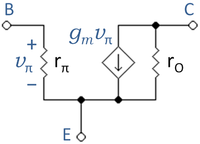User:John R. Brews/WP Import: Difference between revisions
imported>John R. Brews No edit summary |
imported>John R. Brews |
||
| Line 3: | Line 3: | ||
The '''hybrid-pi model''' is a popular [[circuit]] model used for analyzing the [[small signal]] behavior of [[transistors]]. The model can be quite accurate for low-frequency circuits and can easily be adapted for higher frequency circuits with the addition of appropriate inter-electrode [[capacitance]]s and other parasitic elements. | The '''hybrid-pi model''' is a popular [[circuit]] model used for analyzing the [[small signal]] behavior of [[transistors]]. The model can be quite accurate for low-frequency circuits and can easily be adapted for higher frequency circuits with the addition of appropriate inter-electrode [[capacitance]]s and other parasitic elements. | ||
== | ==Bipolar transitor== | ||
The hybrid-pi model is a linearized [[two-port network]] approximation to the transistor using the small-signal base-emitter voltage <math>v_{be}</math> and collector-emitter voltage <math>v_{ce}</math> as independent variables, and the small-signal base current <math>i_{b}</math> and collector current <math>i_{c}</math> as dependent variables. (See Jaeger and Blalock.<ref name=Jaeger1/>) | The hybrid-pi model is a linearized [[two-port network]] approximation to the transistor using the small-signal base-emitter voltage <math>v_{be}</math> and collector-emitter voltage <math>v_{ce}</math> as independent variables, and the small-signal base current <math>i_{b}</math> and collector current <math>i_{c}</math> as dependent variables. (See Jaeger and Blalock.<ref name=Jaeger1/>) | ||
{{Image|Bipolar hybrid-pi model.PNG|right|200px| Simplified, low-frequency hybrid-pi [[BJT]] model.}} | |||
A basic, low-frequency hybrid-pi model for the [[bipolar transistor]] is shown in figure 1. The various parameters are as follows. | A basic, low-frequency hybrid-pi model for the [[bipolar transistor]] is shown in figure 1. The various parameters are as follows. | ||
Revision as of 13:02, 22 May 2011
The hybrid-pi model is a popular circuit model used for analyzing the small signal behavior of transistors. The model can be quite accurate for low-frequency circuits and can easily be adapted for higher frequency circuits with the addition of appropriate inter-electrode capacitances and other parasitic elements.
Bipolar transitor
The hybrid-pi model is a linearized two-port network approximation to the transistor using the small-signal base-emitter voltage and collector-emitter voltage as independent variables, and the small-signal base current and collector current as dependent variables. (See Jaeger and Blalock.[1])
A basic, low-frequency hybrid-pi model for the bipolar transistor is shown in figure 1. The various parameters are as follows.
- is the transconductance in siemens, evaluated in a simple model (see Jaeger and Blalock[2])
- where:
- is the quiescent collector current (also called the collector bias or DC collector current)
- is the thermal voltage, calculated from Boltzmann's constant, the charge on an electron, and the transistor temperature in kelvins. At 300 K (approximately room temperature) is about 26 mV (Google calculator).
- in ohms
- where:
- is the current gain at low frequencies (commonly called hFE). Here is the Q-point base current. This is a parameter specific to each transistor, and can be found on a datasheet; is a function of the choice of collector current.
- is the output resistance due to the Early effect.
Related terms
The reciprocal of the output resistance is named the output conductance
- .
The reciprocal of gm is called the intrinsic resistance
- .
MOSFET parameters

A basic, low-frequency hybrid-pi model for the MOSFET is shown in figure 2. The various parameters are as follows.
is the transconductance in siemens, evaluated in the Shichman-Hodges model in terms of the Q-point drain current by (see Jaeger and Blalock[3]):
- ,
- where:
- is the quiescent drain current (also called the drain bias or DC drain current)
- = threshold voltage and = gate-to-source voltage.
The combination:
often is called the overdrive voltage.
- is the output resistance due to channel length modulation, calculated using the Shichman-Hodges model as
- ,
using the approximation for the channel length modulation parameter λ[4]
- .
Here VE is a technology related parameter (about 4 V / μm for the 65 nm technology node[4]) and L is the length of the source-to-drain separation.
The reciprocal of the output resistance is named the drain conductance
- .
References and notes
- ↑ R.C. Jaeger and T.N. Blalock (2004). Microelectronic Circuit Design, Second Edition. New York: McGraw-Hill, Section 13.5, esp. Eqs. 13.19. ISBN 0-07-232099-0.
- ↑ R.C. Jaeger and T.N. Blalock. Eq. 5.45 pp. 242 and Eq. 13.25 p. 682. ISBN 0-07-232099-0.
- ↑ R.C. Jaeger and T.N. Blalock. Eq. 4.20 pp. 155 and Eq. 13.74 p. 702. ISBN 0-07-232099-0.
- ↑ 4.0 4.1 W. M. C. Sansen (2006). Analog Design Essentials. Dordrechtμ: Springer. ISBN 0-387-25746-2.


























